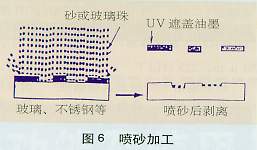3. The role of stress

There is also a way to greatly increase the internal stress of the UV-curable resin and use a special release agent to minimize the gluing function, making it a very easy peelable hiding ink, even if the printing ink film will not break during the peeling. Formed by a tough film. It is used for partial coverage such as painting, or as a temporary protection for the surface of the material and the printing surface, instead of using a protective film.
Chemically functional inks
1. Using absorption and adsorption
   CD-R and CD-RW are used as information recording media. After use, the user wants to mark the surface of the CD with a printer or a note-taking tool. To adapt to this purpose, UV inks suitable for printing are developed. This type of UV varnish is made of a hydrophilic oligomer monomer as a binder. It is screen-printed on the surface of a CD-R and then UV-cured. In addition, a water-based ink or water-based or oily note-taking tool for printing is used for printing. Can also be. After the printing, there is little ink oozing and drying fast.
In addition, UV inks adapted to thermal transfer printers have also been developed.
Functional ink for surface decoration
1. The use of paint, filler decoration

All of these functions depend on fillers. Resin particles such as polyurethane beads and silicon powders and mineral powders are used as fillers.
(1) mirror metal ink
Metal color printing has recently appeared in many fields. As an ink material capable of expressing such a metal tone, metal powder pigments (aluminum powder, copper powder, stainless steel powder, bronze powder, tin powder, etc.) and pearlescent pigments (bead powder, etc.) are often used, and aluminum is most commonly used. Powder (made of aluminum paste) (see Table 4). However, after the screen printing, these metallic pink materials have irregularities and particle sensations on the printed film surface, causing diffusion of light, which makes mirror processing very difficult.

Using special aluminum paste pigments (aluminum is deposited on the film and dissolved in a solvent), the back printing is performed on the transparent printing material, and the smoothness of the material is utilized. Screen printing is used to achieve a vapor deposition foil. With a glossy, glossy finish, mirror metal ink can be used for this type of metal printing.
Mirror metal ink is used in the back printing of transparent plastic materials (polyester, polycarbonate, polypropylene, vinyl chloride). It is a mirror-polished ink through the transparent material. Can be dried at room temperature (20 ~ 30min), if forced drying (80 °C 10 ~ 15rain, 60 °C 15 ~ 20min) mirror effect will be reduced. Its ink film properties (see Table 5).

(2) prismatic ink
Prismatic inks are made of holographic microfine powder finely cut from polyester and used as a color material. The prismatic effect is achieved by the holographic nature of the prismatic ink. A diamond-like brilliance that is not found in metal-based pigments can be obtained.
The powder is agitated in ink and printed on a black background, or printed on the back of a transparant, to give a good color effect. There are three types of fine powders as follows.
#256: 103μm ×100 μm, 150 or less
#375:50μm ×100 μm, less than 180 meshes
#500: 50μm × 50μm, less than 225 mesh
Of course, large-size products have a high prismatic effect and appear brighter. Various specifications are available in silver, gold, copper and tin. Silver has a blue-white sensation and looks brightest. Gold has almost the same brightness as silver. Copper has a reddish color. Its brightness is slightly lower than gold. Tiny color is grayish, and its brightness is slightly lower.
Soft Pastel Drawing Pencils,Charcoal Colored Drawing Pencils,Drawing Natural Color Pencil,Sketch Drawing Pencil
Zhoushan Shenglan Trade Co., Ltd.  , https://www.seamiart.com